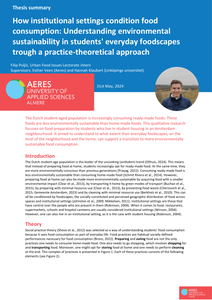High consumption of animal-source foods, specifically meat, adversely affects human health and the environment. Dietary habits are shaped at younger ages and a reduction in meat consumption may be facilitated by the life course transitions in early adulthood, but studies are limited. This study among young Dutch adults aimed to describe their perceptions on the influence of life course transitions on meat consumption, barriers and enablers to reduce meat consumption, and strategies for reducing meat consumption. Barriers and enablers were grouped applying the COM-B model that includes capability, opportunity, and motivation. This quantitative cross-sectional study included a representative sample of 1806 young adults from two Dutch consumer panels who completed an online survey. Young adults frequently reported life course transitions, especially those related to moving house, to have decreased their meat consumption. Barriers and enablers to reduce meat consumption were identified for all three factors of the COM-B model. Important barriers included taste, perceived high prices of meat alternatives, and habits. In contrast, important enablers included care for the environment and animal welfare, enjoyment of smaller portions of meat and saving money. However, barriers and enablers largely differed by groups of meat consumption frequency. Self-perceived effective strategies for reducing meat consumption were price reduction of meat alternatives, recipes for vegetarian meals, and more attractive meat alternatives. The findings of this study are relevant for the development of targeted behaviour-change programmes including interventions in the physical and the social environment (like lowering prices and improving the offer of meat alternatives).
MULTIFILE

The Dutch market for meat substitutes has grown steadily, however, their market share is still low, and meat consumption in the Netherlands is not decreasing. For a transition towards a more plant-based diet, understanding consumer motives regarding meat substitutes is important. The purpose of this study was to explore what motives lay behind the appropriateness of the use of meat substitutes in different usagesituations.
LINK
Environmental or ‘green' education is an important driving force behind the ‘greening' of society as it plays a critical role in raising environmental awareness and preparing students for green jobs. None of the existing environmental attitudes and behavior measures is focused on the evaluation of green education, especially in relation to consumption. To date, no longitudinal studies of children and students' attitudes towards consumption influenced by education exist. Also, little has been done to explore the socio-cultural context in which attitudes toward consumption are being formed and to explain the cross-cultural differences in environmental attitudes. This pilot study is designed to take the first step towards developing methods complementing existing quantitative measurements with qualitative strategies, such as consumption diaries, focus groups, and concept mapping. While this research is just a first attempt to tackle children's knowledge and attitudes consumption, preliminary results of the research on which this chapter is based and enthusiasm of the research participants encourage the author to stress the importance of consumption studies as part of green education for educational program developers. As a chapter of this volume, the author hopes that this study will add to the anthropological depository of research on the cultural variants in the perception of the environment in children. This chapter draws upon the consumption diaries collected from the upper-elementary school children in Amsterdam, The Netherlands, between September 2009 and May 2010. Consumption diaries are chronological documents recording purchase, use, and waste of materials, which can be used both as analytical tools and the means to stimulate environmental awareness. The four main methodological steps involved in this research were as follows. Children were asked to complete the consumption diary, paying specific attention to use and waste materials. Consequently, focus group meetings were held with parents and their children to discuss the diaries. Finally, interviews with the children were conducted in order to generate statements that supplement those generated by focus groups for carrying out the concept mapping analysis. The concept mapping analysis was then conducted to organize the order and analyze the ideas expressed in the focus group and interview sessions. This is an Accepted Manuscript of a book chapter published by Routledge/CRC Press in "Environmental Anthropology Today" on 8/5/11 available online: https://doi.org/10.4324/9780203806906 LinkedIn: https://www.linkedin.com/in/helenkopnina/
MULTIFILE

Due to a growing challenge to feed the world’s population and an increased awareness to minimize the impact of our food choices on climate change, a more plant-based diet has gained popularity with a growing number of plant-based products on the market. To stimulate a plant-based diet that also improves long-term health, data are needed to monitor whether these products are healthy alternatives to animal-based foods. Therefore, this study inventoried 916 plant-based meat, fish, and dairy alternatives from eight Dutch supermarkets. The nutritional quality of each product was assessed by (1) the Dutch food-based dietary guidelines and (2) the Nutri-Score. The results show that over 70% of meat, fish, and dairy alternatives have an A/B Nutri-Score (indicating high nutritional quality), but do not comply with the Dutch dietary guidelines. This is mainly due to high salt and low vitamin B12 and iron content (meat and fish alternatives) or low protein and calcium levels (dairy alternatives). In conclusion, the majority of plant-based products are nutritionally not full alternatives of the animal-based equivalents; however, there are still opportunities for reformulation. To aid the consumer in making healthy plant-based food choices, a better alignment between the Nutri-Score and the recommended dietary guidelines is needed.
DOCUMENT

Consumer concern for animal welfare is currently not fully reflected in the market share of welfare-enhanced meat. A possible solution is developing marketing strategies that emphasize personally relevant benefits such as taste and curiosity, instead of having a sole focus on sustainability-related benefits, since existing research indicates that the former are more appealing to most consumers. This study tests strategies positioning welfare-enhanced meat as personally relevant in a real-life experiment and how consumer attitudes towards eating meat influence reactions to the positioning strategies. The study conducts experimental auctions with 101 Dutch university students, manipulating the positioning strategy and a certified animal welfare label and measuring participants’ willingness to pay (WTP) for a lunch meal with chicken meat. Results indicate that all manipulations significantly increase consumer WTP, with higher WTP for certified labels than for the positioning strategy, and the highest WTP for the combination of both elements (without providing evidence for an interaction effect). This implies that companies should combine positioning strategies that emphasize personally relevant benefits with certified labels. Since the effectiveness of such strategies may be limited for consumers with conflicting feelings towards meat, some care should be taken when designing awareness campaigns about the effects of meat consumption
DOCUMENT
INTRODUCTION: Sufficient high quality dietary protein intake is required to prevent or treat sarcopenia in elderly people. Therefore, the intake of specific protein sources as well as their timing of intake are important to improve dietary protein intake in elderly people.OBJECTIVES: to assess the consumption of protein sources as well as the distribution of protein sources over the day in community-dwelling, frail and institutionalized elderly people.METHODS: Habitual dietary intake was evaluated using 2- and 3-day food records collected from various studies involving 739 community-dwelling, 321 frail and 219 institutionalized elderly people.RESULTS: Daily protein intake averaged 71 ± 18 g/day in community-dwelling, 71 ± 20 g/day in frail and 58 ± 16 g/day in institutionalized elderly people and accounted for 16% ± 3%, 16% ± 3% and 17% ± 3% of their energy intake, respectively. Dietary protein intake ranged from 10 to 12 g at breakfast, 15 to 23 g at lunch and 24 to 31 g at dinner contributing together over 80% of daily protein intake. The majority of dietary protein consumed originated from animal sources (≥60%) with meat and dairy as dominant sources. Thus, 40% of the protein intake in community-dwelling, 37% in frail and 29% in institutionalized elderly originated from plant based protein sources with bread as the principle source. Plant based proteins contributed for >50% of protein intake at breakfast and between 34% and 37% at lunch, with bread as the main source. During dinner, >70% of the protein intake originated from animal protein, with meat as the dominant source.CONCLUSION: Daily protein intake in these older populations is mainly (>80%) provided by the three main meals, with most protein consumed during dinner. More than 60% of daily protein intake consumed is of animal origin, with plant based protein sources representing nearly 40% of total protein consumed. During dinner, >70% of the protein intake originated from animal protein, while during breakfast and lunch a large proportion of protein is derived from plant based protein sources.
DOCUMENT

In reflecting on Dutch Christmas shoppers, this article will discuss environmental Kuznets curve (EKC), postmaterialist values hypothesis, and ecological modernization theory. According to the EKC hypothesis, while at the initial stages of industrialization material resources are often used unsustainably, continuing industrialization leads to a threshold after which lead to progressively more sustainable technologies. According to the postmaterialist values hypothesis, only wealthier societies can ‘afford’ to care about the environment, assuming that wealth will lead to development of greater concern about and valuation of environment. Finally, ecological modernization theory postulates that environmental conditions improve with advanced technological development and suggests that enlightened self-interest, economy and ecology can be favourably combined and that productive use of natural resources can be a source of future growth. In generalizing economic, political and social trends in relation to consumption in The Netherlands, the aim of this article is to consider the consequences of Western-style consumption for the enterprise of global development. https://doi.org/10.1016/j.scs.2013.05.004 https://www.linkedin.com/in/helenkopnina/
MULTIFILE

The Dutch student-aged population is increasingly consuming ready-made foods. These foods are less environmentally sustainable than home-made foods. This qualitative research focuses on food preparation by students who live in student housing in an Amsterdam neighbourhood. It aimed to understand to what extent their everyday foodscapes, on the level of the neighborhood and the home, can support a transition to more environmentally sustainable food consumption. This is a thesis summary.
DOCUMENT

Vlees eten is geworteld in onze eetcultuur. Het minderen van vlees vraagt tijd. Ondanks campagnes die plantaardige diëten promoten eet volgens CBS nog zo’n 95% van de Nederlanders vlees, en de meeste daarvan doen dat meerdere keren per week als een stukje vlees bij de maaltijd. Om op kortere termijn een verschil te maken, zal het stimuleren van consumentenkeuzes voor duurzaam geproduceerd vlees in belangrijke mate bijdragen aan “minder en beter”. Dit vraagt om specifieke tactieken, wetende dat consumenten in hun gedrag niet altijd doen dan wat hun intentie is met betrekking tot duurzaamheid: de wil is er, maar vertaalt zich onvoldoende in koopgedrag. Om dit te overkomen zijn marketinginterventies nodig die de capaciteit, gelegenheid en motivatie van consumenten verhogen/versterken. Deze rapportage bevat de resultaten – op hoofdlijnen – van een kwalitatief onderzoek, waarin types en empathy maps van verschillende consumententypen en hun meest onderscheidende variabelen in kaart zijn gebracht.
DOCUMENT

Hundreds of sensors in our smartphones, cars, houses and other "smart" devices feed the IoT, that monitors both our functioning, and that of the smart devices. In 2050 the Internet of Things - which processes and stores all sensor data - will require a multiple of all the current energy together in air traffic and meat consumption. Living an environmentally friendly life will be just a drop in the ocean. With every step we take, servers all over the world start to analyze and store sensor data from the smartphone in our pocket. Habermas states that the system supplants ("colonizes") the lifeworld. It is of great importance that economic and social disciplines make a serious effort to restore the balance between the system world and the lifeworld.
MULTIFILE
